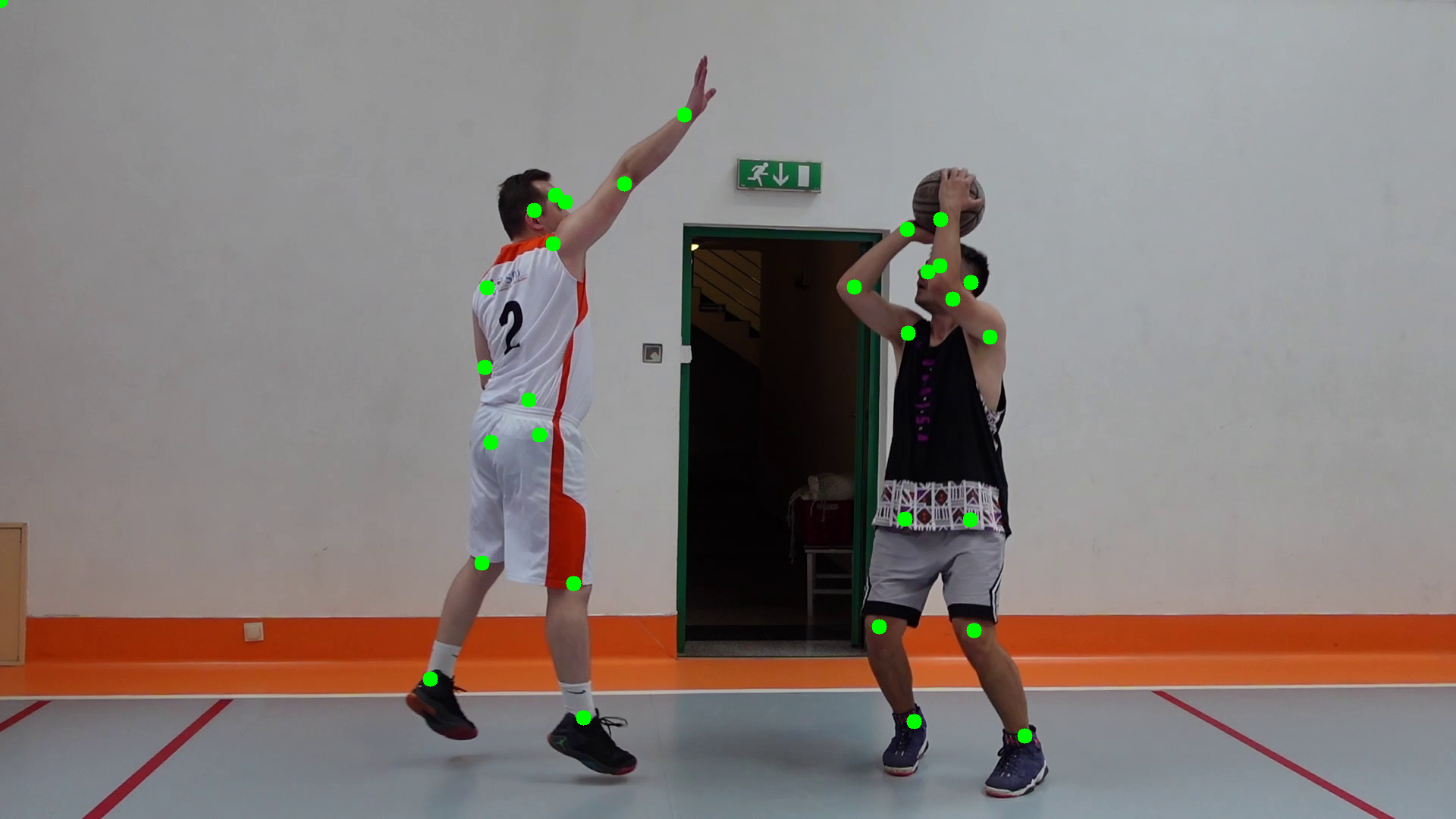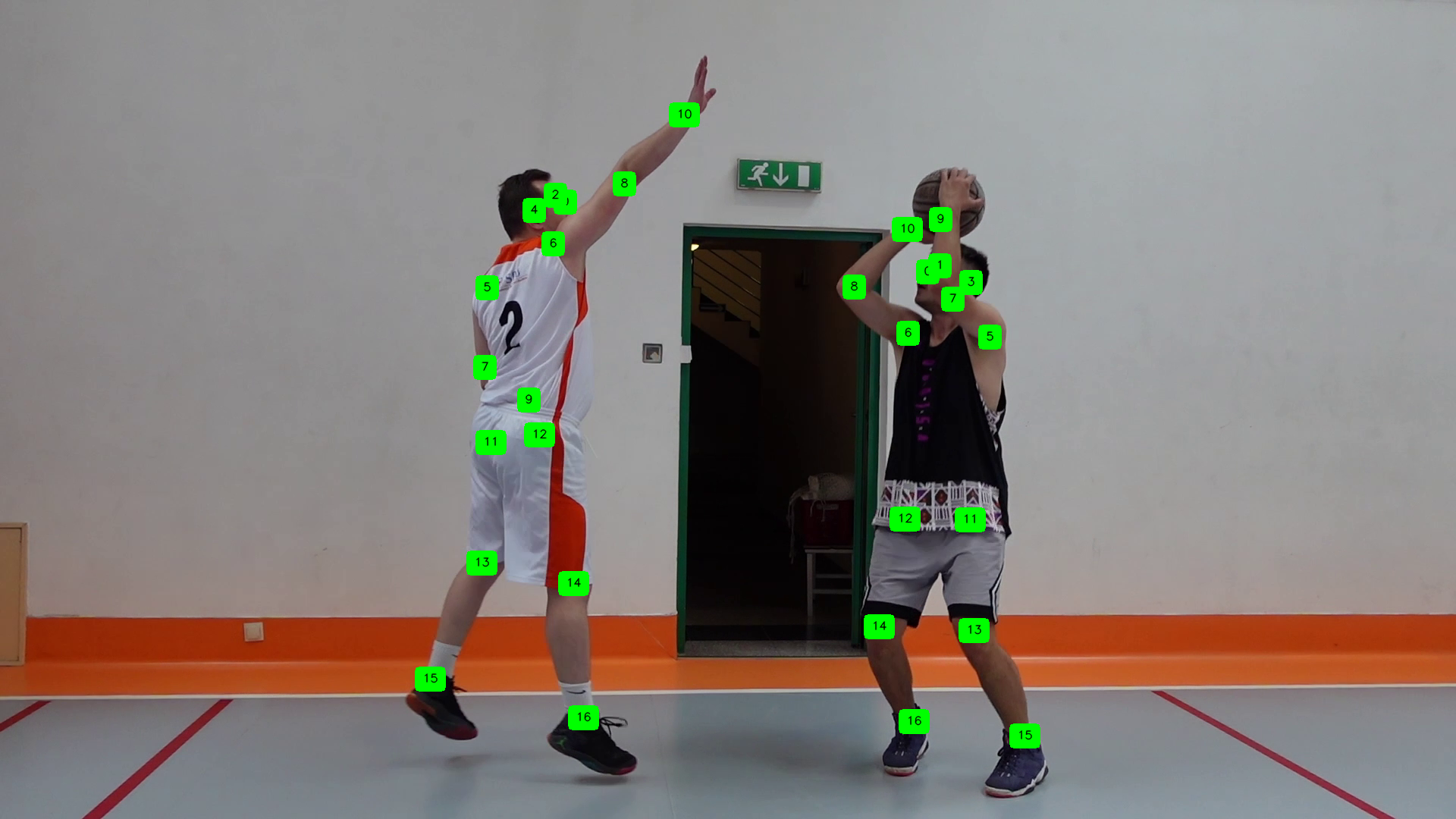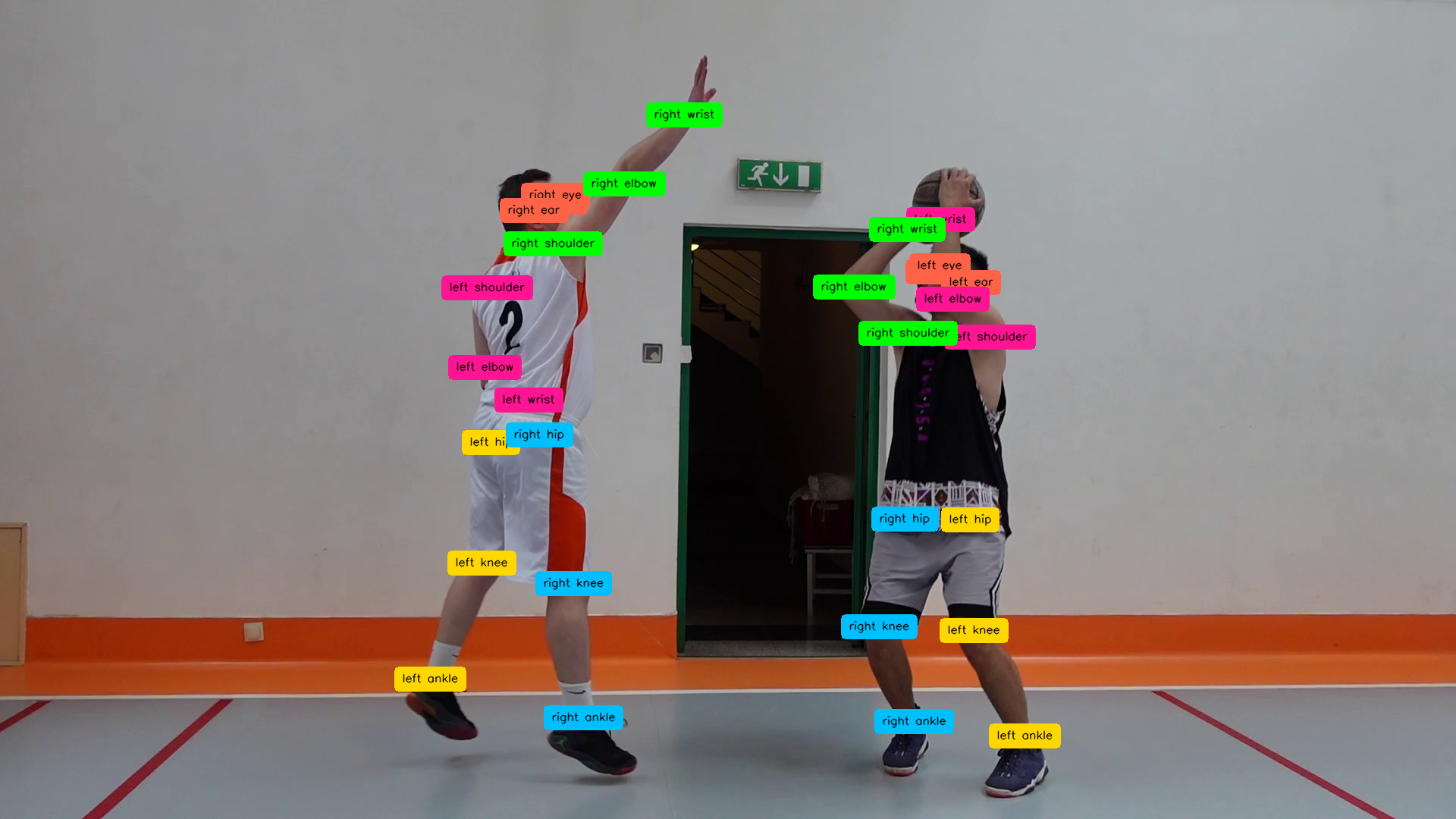Annotators¶
import supervision as sv
image = ...
key_points = sv.KeyPoints(...)
vertex_annotator = sv.VertexAnnotator(
color=sv.Color.GREEN,
radius=10
)
annotated_frame = vertex_annotator.annotate(
scene=image.copy(),
key_points=key_points
)

Bases: BaseKeyPointAnnotator
A class that specializes in drawing skeleton vertices on images. It uses specified key points to determine the locations where the vertices should be drawn.
Source code in supervision/keypoint/annotators.py
Functions¶
__init__(color=Color.ROBOFLOW, radius=4)
¶
Parameters:
| Name | Type | Description | Default |
|---|---|---|---|
color |
Color
|
The color to use for annotating key points. |
ROBOFLOW
|
radius |
int
|
The radius of the circles used to represent the key points. |
4
|
Source code in supervision/keypoint/annotators.py
annotate(scene, key_points)
¶
Annotates the given scene with skeleton vertices based on the provided key points. It draws circles at each key point location.
Parameters:
| Name | Type | Description | Default |
|---|---|---|---|
scene |
ImageType
|
The image where skeleton vertices will be drawn.
|
required |
key_points |
KeyPoints
|
A collection of key points where each key point consists of x and y coordinates. |
required |
Returns:
| Type | Description |
|---|---|
ImageType
|
The annotated image, matching the type of |
Example

Source code in supervision/keypoint/annotators.py
Bases: BaseKeyPointAnnotator
A class that specializes in drawing skeleton edges on images using specified key points. It connects key points with lines to form the skeleton structure.
Source code in supervision/keypoint/annotators.py
97 98 99 100 101 102 103 104 105 106 107 108 109 110 111 112 113 114 115 116 117 118 119 120 121 122 123 124 125 126 127 128 129 130 131 132 133 134 135 136 137 138 139 140 141 142 143 144 145 146 147 148 149 150 151 152 153 154 155 156 157 158 159 160 161 162 163 164 165 166 167 168 169 170 171 172 173 174 175 176 177 178 179 180 181 182 183 184 185 | |
Functions¶
__init__(color=Color.ROBOFLOW, thickness=2, edges=None)
¶
Parameters:
| Name | Type | Description | Default |
|---|---|---|---|
color |
Color
|
The color to use for the edges. |
ROBOFLOW
|
thickness |
int
|
The thickness of the edges. |
2
|
edges |
Optional[List[Tuple[int, int]]]
|
The edges to draw.
If set to |
None
|
Source code in supervision/keypoint/annotators.py
annotate(scene, key_points)
¶
Annotates the given scene by drawing lines between specified key points to form edges.
Parameters:
| Name | Type | Description | Default |
|---|---|---|---|
scene |
ImageType
|
The image where skeleton edges will be drawn. |
required |
key_points |
KeyPoints
|
A collection of key points where each key point consists of x and y coordinates. |
required |
Returns:
| Name | Type | Description |
|---|---|---|
Returns |
ImageType
|
The annotated image, matching the type of |
Example

Source code in supervision/keypoint/annotators.py
A class that draws labels of skeleton vertices on images. It uses specified key points to determine the locations where the vertices should be drawn.
Source code in supervision/keypoint/annotators.py
188 189 190 191 192 193 194 195 196 197 198 199 200 201 202 203 204 205 206 207 208 209 210 211 212 213 214 215 216 217 218 219 220 221 222 223 224 225 226 227 228 229 230 231 232 233 234 235 236 237 238 239 240 241 242 243 244 245 246 247 248 249 250 251 252 253 254 255 256 257 258 259 260 261 262 263 264 265 266 267 268 269 270 271 272 273 274 275 276 277 278 279 280 281 282 283 284 285 286 287 288 289 290 291 292 293 294 295 296 297 298 299 300 301 302 303 304 305 306 307 308 309 310 311 312 313 314 315 316 317 318 319 320 321 322 323 324 325 326 327 328 329 330 331 332 333 334 335 336 337 338 339 340 341 342 343 344 345 346 347 348 349 350 351 352 353 354 355 356 357 358 359 360 361 362 363 364 365 366 367 368 369 370 371 372 373 374 375 376 377 378 379 380 381 382 383 384 385 386 387 388 389 390 391 392 393 394 395 396 397 398 399 400 401 402 403 404 405 406 407 408 409 410 411 412 413 414 415 416 417 418 | |
Functions¶
__init__(color=Color.ROBOFLOW, text_color=Color.WHITE, text_scale=0.5, text_thickness=1, text_padding=10, border_radius=0)
¶
Parameters:
| Name | Type | Description | Default |
|---|---|---|---|
color |
Union[Color, List[Color]]
|
The color to use for each keypoint label. If a list is provided, the colors will be used in order for each keypoint. |
ROBOFLOW
|
text_color |
Color
|
The color to use for the labels. |
WHITE
|
text_scale |
float
|
The scale of the text. |
0.5
|
text_thickness |
int
|
The thickness of the text. |
1
|
text_padding |
int
|
The padding around the text. |
10
|
border_radius |
int
|
The radius of the rounded corners of the boxes. Set to a high value to produce circles. |
0
|
Source code in supervision/keypoint/annotators.py
annotate(scene, key_points, labels=None)
¶
A class that draws labels of skeleton vertices on images. It uses specified key points to determine the locations where the vertices should be drawn.
Parameters:
| Name | Type | Description | Default |
|---|---|---|---|
scene |
ImageType
|
The image where vertex labels will be drawn. |
required |
key_points |
KeyPoints
|
A collection of key points where each key point consists of x and y coordinates. |
required |
labels |
List[str]
|
A list of labels to be displayed on the annotated image. If not provided, keypoint indices will be used. |
None
|
Returns:
| Type | Description |
|---|---|
ImageType
|
The annotated image, matching the type of |
Example

Tip
VertexLabelAnnotator allows to customize the color of each keypoint label
values.
Example
import supervision as sv
image = ...
key_points = sv.KeyPoints(...)
LABELS = [
"nose", "left eye", "right eye", "left ear",
"right ear", "left shoulder", "right shoulder", "left elbow",
"right elbow", "left wrist", "right wrist", "left hip",
"right hip", "left knee", "right knee", "left ankle",
"right ankle"
]
COLORS = [
"#FF6347", "#FF6347", "#FF6347", "#FF6347",
"#FF6347", "#FF1493", "#00FF00", "#FF1493",
"#00FF00", "#FF1493", "#00FF00", "#FFD700",
"#00BFFF", "#FFD700", "#00BFFF", "#FFD700",
"#00BFFF"
]
COLORS = [sv.Color.from_hex(color_hex=c) for c in COLORS]
vertex_label_annotator = sv.VertexLabelAnnotator(
color=COLORS,
text_color=sv.Color.BLACK,
border_radius=5
)
annotated_frame = vertex_label_annotator.annotate(
scene=image.copy(),
key_points=key_points,
labels=labels
)

Source code in supervision/keypoint/annotators.py
222 223 224 225 226 227 228 229 230 231 232 233 234 235 236 237 238 239 240 241 242 243 244 245 246 247 248 249 250 251 252 253 254 255 256 257 258 259 260 261 262 263 264 265 266 267 268 269 270 271 272 273 274 275 276 277 278 279 280 281 282 283 284 285 286 287 288 289 290 291 292 293 294 295 296 297 298 299 300 301 302 303 304 305 306 307 308 309 310 311 312 313 314 315 316 317 318 319 320 321 322 323 324 325 326 327 328 329 330 331 332 333 334 335 336 337 338 339 340 341 342 343 344 345 346 347 348 349 350 351 352 353 354 355 356 357 358 359 360 361 362 363 364 365 | |

